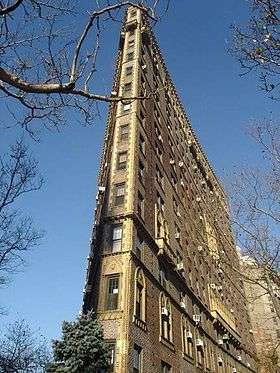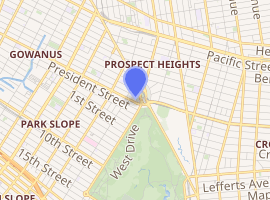47 Plaza Street West
47 Plaza Street West is an apartment building designed by the noted architect Rosario Candela and completed in 1928 in Park Slope, Brooklyn, New York City. The building, located next to Brooklyn's Grand Army Plaza, possesses a distinctive flatiron shape.[2]
| 47 Plaza Street West | |
|---|---|
 | |

| |
| General information | |
| Type | Residential |
| Architectural style | Venetian Gothic |
| Location | 47-61 Plaza Street West, Park Slope, Brooklyn, New York City, U.S. |
| Coordinates | 40°40′24″N 73°58′17″W |
| Completed | 1928 |
| Height | 165 feet |
| Technical details | |
| Floor count | 16 |
| Design and construction | |
| Architect | Rosario Candela |
| References | |
| [1] | |
History
In the mid 1920s Plaza Street, which had been developed as part of Park Slope's "Gold Coast" neighborhood, was mainly composed of very large single-family mansions. In 1925, with Brooklyn real estate booming, the first high-rise apartment building on Plaza Street was built, 1 Plaza Street West, at the corner of Plaza Street West and Flatbush Avenue.
Real estate brochures of the era touted Plaza Street and its environs as the "Park Avenue District of Brooklyn."
In 1926 developer Jacob Mark retained Rosario Candela to design 39 Plaza Street, at the corner of Plaza Street and Berkeley Place, known as the Berkeley Plaza Apartments. By this time Candela was very much on his way to becoming the most noted architect of luxury apartments on Manhattan's Park and Fifth Avenues.
In 1927 Mark again commissioned Candela to design the flatiron building at the corner of 47 Plaza Street West. This multiple dwelling replaced a large single-family home then occupied by shipbuilding magnate Edward P. Morse. When the new apartment building was completed in November 1928, Morse and his family rented three of the apartments.
Today, 47 Plaza Street West is included in the Park Slope Historic District, designated in 1973 by the Landmarks Preservation Commission and added to the National Register of Historic Places in 1980.[3]
Design
Candela was especially known for his intricate and clever use of space in the puzzle-like design of New York City apartments. While 47 Plaza Street was not his most luxurious design, his ingenious use of room configurations in this unconventional footprint is probably one of his most fascinating works.
The building was laid out with three large apartments per floor. The standard layout is one Classic 7, which culminates at the point on Union Street, and two Classic 6 apartments.
Candela also loved puzzles and he left many subtle clues to this passion at 47 Plaza Street. Although the Plaza Street facade is concave, the point culminates at an angle of 47 degrees.
Including the doctors' suites and the superintendent's flat there are 47 units.
There was also a dash of theatrical whimsy to Candela's design. The elevator that leads to the grand penthouse has a panel in the Mahogany wood interior that flips open to reveal the front door of the penthouse. The access to the other apartments is through a standard elevator door.
The exterior is perhaps one of Candela's most distinctive and is done in an Italianate Venetian Gothic style. It has been suggested that Candela was likely inspired by the Montauk Club, a Park Slope landmark two blocks up Plaza Street, although there is no written record to support this.
The point was designed with a right angle at the corner of Plaza and Union streets so that, if looked at from the correct perspective, the structure appears to be a wafer no wider the six feet.
Significance
Candela designed only two pre-war residential buildings in Brooklyn, 39 and 47 Plaza Street, both for real estate developer Jacob Mark, both on the same block.
With its prominent position at the southwestern edge of Grand Army Plaza, 47 Plaza Street is considered something of an unofficial landmark of this most monumental of Brooklyn public spaces.
In popular culture
The manually operated elevators at 47 Plaza Street West were featured in a New York Times article in the December 15, 2017 edition of the newspaper https://www.nytimes.com/2017/12/15/nyregion/manual-elevators-operators.html.
The piece, written by Andy Newman, was devoted to the diminishing number of manual elevators in New York City buildings and focused in large part on 47 Plaza Street West and one of its elevator operators.
References
| Wikimedia Commons has media related to 47 Plaza Street West. |
- "47 Park Street West". Emporis. Retrieved March 1, 2017.
- "Brooklyn's Very Own Flatiron Building". Archived from the original on January 27, 2011. Retrieved June 18, 2010.
- "Park Slope Historic District Designation Report" (PDF). Landmarks Preservation Commission. Retrieved March 1, 2017.